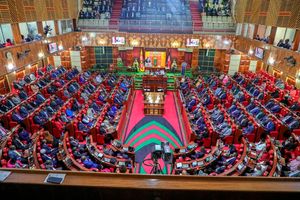TB remains a nightmare, but it’s not all doom and gloom

Network of Tuberculosis Champions Kenya National Coordinator Stephen Shikoli during the interview at Nation Center on January 28, 2023.
What you need to know:
- As the world races to develop a vaccine against tuberculosis, the infectious disease continues to be a public health menace in Kenya.
- Kenya is on the list of the countries with a high TB burden globally and among the 30 countries that contribute to 80 per cent of the global TB burden.
- In Africa, Kenya ranks fourth after South Africa, Nigeria, and Ethiopia.
For the past 11 years, Stephen Shikoli, 31, has been traversing the world relentlessly fighting tuberculosis (TB) and creating awareness to save thousands of lives.
In 2009, Stephen, born and bred in Kangemi on the outskirts of Nairobi, experienced the worst incident of his life after being shunned and chased away by his own mother for testing positive for TB.
From this ordeal, he has dedicated his life to extend the empathy showed to him by his childhood friend and community health workers, who assisted him through treatment.
A curse
“Latent TB claimed the lives of my sister in 2007 at the age of five and my brother in 2015 at the age of 26.
“My battle with TB began in January 2009 with persistent coughs, night sweats and lots of trouble breathing. I took normal antibiotics and herbs and even resorted to prayers because I had been made to believe that perhaps someone had cursed me.
“When it got worse, I decided to shave my dreadlocks thinking it could be the reason for the never-ending profuse night sweats,” he started off.
Stephen noted that as the symptoms persisted, his friend advised him to go to a hospital and properly get checked. At this time, he did not know where Kangemi Health Centre was located despite being born there.
“So I went to Westlands health centre, where they took my sputum spot samples and gave me two other small bottles to fill up, which I would take back the next morning.
“When I returned to the health facility the next day, it was confirmed, as per my first cycle of results, that I had tested positive for TB and was advised to visit Kangemi Health Centre due to its proximity to home for treatment.
“My mother had a difficult time coming to terms with those results. ‘This is a curse,’ she said. She suggested I go for a chest X-ray, which would potentially see me part with Sh1,000 and because I was stressed and just wanted to get treatment, I tore the note she had put in my hand into pieces and never went for the X-ray.
“Upon realising what I had done later that afternoon, together with a neighbour, they dragged me to another health centre because the Kangemi one had not started offering X-ray services at the time, and then, the positive results were confirmed.
“My devastated mother was counselled and given all the information she needed but her denial still took the better part of her because as soon as we reached home that very same day, she would chase me away.
“I was very sick at this point, had lost 20kgs from 60 to 40. I was then 17-years-old and only able to move with the aid of a walking stick. But this did not break my heart because I took a decision to go for treatment without looking back.”
Stephen’s long-term friend who was very supportive throughout took him in and took an initiative to religiously ensure he receives treatment and takes the prescribed medication, which would see him recover, regain weight and get rid of the walking stick in just a month.
Stephen disclosed that the support he got from community health workers who hail from Kangemi motivated him to start Pamoja TB group while still on treatment.
“I have now dedicated my life to using the platform to offer psychosocial support to those who are on treatment, walking the treatment journey together as we fight stigma and discrimination in the community,” he told Healthy Nation.
“Together with Evaline Kibuchi, a public health advocate and the Chief National Coordinator Stop TB Partnership-Kenya, and several other TB-affected communities, we decided to start the Network of TB Champions, which was registered as an NGO in 2019 and draws members from all counties.”
Stephen’s incident is not only one out of an estimated 139,000 known cases of TB recorded in Kenya, but it is also among types of TB that silently infect people known as Latent TB.
Causing illness
According to the Centers for Disease Control and Prevention (CDC), not everyone infected with TB bacteria becomes sick and as a result, two TB-related conditions exist: latent TB infection and TB disease. The TB bacteria can live in the body without causing illness.
Latent TB infection occurs when a person is infected with the TB bacteria but does not have any symptoms.

It is estimated that one quarter of the world’s population (an estimated 1.7 billion people) is latently infected with the TB bacteria. Of these, five to 10 per cent are at risk of progressing to TB disease.
“This is called latent TB infection. In most people who breathe in TB bacteria and become infected, the body is able to fight the bacteria to stop them from growing.”
Experts observe that people with latent TB infection have no symptoms, do not feel sick, cannot spread TB bacteria to others, usually have a positive TB skin test reaction or positive TB blood test, and may develop TB disease if they do not receive treatment for latent TB infection.
“My doctor told me that the majority of the world’s population is infected with latent. However, those whose immune systems get compromised develop active TB,” Stephen said.
Ms Kibuchi told Healthy Nation that TB continues to be a public health menace in Kenya.
“In 2021 alone approximately 1.6 million died from TB globally. Kenya is on the list of the countries with a high TB burden globally and among the 30 countries that contribute to 80 per cent of the global TB burden. In Africa, Kenya ranks fourth after South Africa, Nigeria, and Ethiopia in that order and even with such a ranking, the country has continued to record great progress in combating the disease and has recorded a tremendous drop in TB-related mortalities from about 33,000 TB-related deaths in 2019 to 21,000 in 2021, according to the latest WHO global TB report.”
Although Kenya has made great progress, about 50 per cent of all people infected with the disease remain undiagnosed. This poses a great danger because they continue infecting others thus risking death if those infected remain undiagnosed and untreated.”
“According to the TB prevalence survey conducted in 2016, men are twice as infected as women,” said Ms Kibuchi.
This means that Kenya is among 30 high-burden countries for both TB and TB/HIV globally according to the WHO and this is why it is among 11 other high-burden countries that were last year prioritised to rapidly roll out the package of the latest innovations.
In 2021, the incidence was estimated at 140,000 people according to Dr Nazila Ganatra, the head of strategic, public health programmes at the Ministry of Health, while that of drug-resistant TB (DR-TB) was put at 2,500.
“Last year the ministry through the National TB Programme diagnosed and started treating 77,854 people with drug-susceptible tuberculosis (DS-TB) and an additional 804 with DR-TB. To be approximate, 77,000 people represents coverage of a little above 50 per cent, this means we need an account of 40 per cent of people with TB,” Dr Ganatra highlighted.
But it is not all doom and gloom as Ms Kibuchi noted that the country is among a few on the list of high-burden countries that have achieved and surpassed the 2020 targets of reducing both TB-related deaths and new incidences.
“Other countries that have achieved this include Eswatini, Togo, Tanzania and Zambia.”
To sustain the gains made to combat the epidemic, she explained that there is need to sustain community engagement by supporting them to continue with their work on TB. “It is also important to maintain political goodwill by bringing the President on board in the fight against the disease.”
Dr Ganatra said the government has embarked on rolling out the Artificial Intelligence (AI)-enabled digital X-ray, a portable device particularly used for screening patients in high-risk groups and hard-to-reach areas.
“These digital CXRs (chest) are also able to interpret X-ray results using computer-aided technology and therefore very useful where radiologists are not readily available,” Dr Ganatra added.
She further disclosed that the Health ministry will be disbursing 38 truenat machines across 33 counties, eight digital CXRs to seven counties, and digital adherence technology (DAT) , which will aid in enhancing adherence to TB treatment. They will be spread across 186 facilities in Nairobi County.
“The tools launched through the Introducing New Tools Project (iNTP) initiative include the use of truenat, a machine that is portable, battery-operated molecular TB test that can be used easily in hard-to-reach areas where reliable electricity supply is not assured or where there is need to conduct community outreaches to diagnose TB in various key populations.
There are also programmes geared towards creating awareness in the community as well as increased political will, with a TB caucus in Parliament which advocates for TB issues within the August House. It is chaired by Matungulu MP Stephen Mule.
The world is also in a race to develop a vaccine against the infectious disease.The current BCG vaccine provides moderate protection against severe forms of TB in infants and young children.
But there is also no vaccine that is effective in preventing the disease in adults, either before or after exposure to infection. Experts have been racing against time to develop new TB vaccines that can prevent disease in people who have been exposed to the bacteria and stop infections before they happen.

Tuberculosis vaccine for injection. PHOTO|Shutterstock
While making the announcement on the new BCG tuberculosis vaccine at the Indian Science Congress, Dr Shekhar Mande, the former director general of the Council of Scientific and Industrial Research, explained how technology has helped doctors and researchers understand TB better, paving ways to combat the infectious disease.
“We are mainly focusing on new medicines and drugs for tuberculosis. We are doing background work and setting targets on research for prevention of tuberculosis, “ he highlighted while adding that the clinical trials will start soon.
One of the most promising ways of controlling TB is something called DOTS therapy ( directly observed treatment,short-course) in which the patient takes medicine in the presence of a doctor and the therapy is continued for six to eight months and completed in the best possible way,” he explained.
According to the world’s biggest vaccine maker Serum Institute of India, which has applied for emergency use authorisation with the Drug Controller General of India for its recombinant BCG vaccine TUBERVAC-rBCG, the jab will help adult TB patients.
This is the second TB vaccine that the Asian country is currently working on.
Speaking to Healthy Nation, Dr Gitahi Githinji, the Chief Executive Officer at Amref Health Africa, said a TB vaccine from India would be good news for Kenya.
“Everyone, including Kenya needs a TB vaccine for adults as that’s where the burden is yet we only have neonatal BCG.”
Dr Calvin Lwaka, the director of programmes at Elizabeth Glaser Paediatric AIDS Foundation, agreed with Dr Githinji, urging the country to focus on identifying new TB cases. “TB vaccine (BCG) offers protection against severe forms of TB in children – TB meningitis and disseminated TB hence improves child survival. However it does not protect against primary TB infection and does not prevent reactivation of Latent TB infection,” he said while pointing out what we must now do.
“We must therefore actively identify new TB cases in all health service delivery points to ensure patients access treatment as soon as possible. We must also adopt the use of new technologies like artificial intelligence to help diagnosis in rural health facilities that have limited access to radiologists.”




